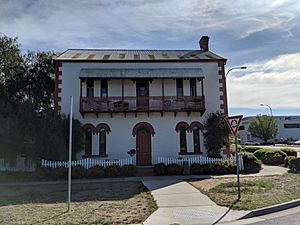Byrnes Mill and Millhouse facts for kids
Quick facts for kids Byrnes Mill and Millhouse |
|
|---|---|

Byrnes Mill and Millhouse, 2018
|
|
| Location | Morrisett Street, Queanbeyan, Queanbeyan-Palerang Region, New South Wales, Australia |
| Official name: Mill and Millhouse; Byrnes Mill | |
| Type | State heritage (built) |
| Designated | 2 April 1999 |
| Reference no. | 363 |
| Type | Mill (Grain) - Corn |
| Category | Manufacturing and Processing |
| Lua error in Module:Location_map at line 420: attempt to index field 'wikibase' (a nil value). | |
Byrnes Mill and Millhouse is a special old building in Queanbeyan, New South Wales, Australia. It used to be a flour mill and a home. Today, it is protected as a heritage site. It was added to the New South Wales State Heritage Register on April 2, 1999.
History of Byrnes Mill
The mill was built for Martin Byrne. He was a very important landowner and businessman in Queanbeyan. Martin Byrne had wanted to build a mill since 1870. But he only started building it in 1883.
He hired William Crispin, an experienced mill builder from Sydney. Crispin then hired local builders Thomas Jordan and Thomas McCauley. Crispin designed the mill and watched over the building work. Jordan and McCauley did the actual building.
The building was made of brick and finished in September 1883. It cost 3,500 pounds, which was a lot of money back then! The mill had a powerful fifteen-horsepower engine. It also had three pairs of elevators to move grain. A tall smokestack, about 18 meters (60 feet) high, stood next to the building.
The mill started working in December 1883. Its two employees made forty bags of flour every day. Martin's son, James, managed the mill. James and his family lived in the two-story mill house next door. The mill house was built at the same time as the mill.
In 1887, the railway came to Queanbeyan. This meant cheaper flour from Sydney could be brought into town. Two years later, another mill started being built near the new railway station. Martin Byrne realized he could not compete with the new, cheaper flour. So, he closed his mill in 1889 and put it up for sale.
After closing, the mill was used for many years as a storage place for farm goods. At one point, a company called J. B. Young's bought it for storage. In the 2000s, it was used as a restaurant, but that has now closed.
James Byrne lived in the mill house until his wife passed away in 1902. After that, different people lived in the mill house. These included William Hill, Reginald Tetley, and Archibald Campbell. Later, J. B. Young's company used it as a home for their employees. In the early 1980s, the building had craft stores and a bookshop. It then became a home again for a while. Today, it is home to the Millhouse Cafe.
What Byrnes Mill Looks Like
Byrne's Mill was one of six mills that operated in the Canberra-Queanbeyan area over time. The mill building has three stories and is made of brick. It has a corrugated steel roof that slopes down on two sides, called a gable roof.
The windows have slightly rounded tops. There is a hoist and a door on the top story for lifting things. High up in the triangular parts of the roof, called the gable ends, there are small windows. These look like windows for an attic.
The mill house, or former manager's house, is also a two-story brick building. It has a corrugated steel roof. The main roof is a gable, and there's a smaller, single-sloping roof at the back called a skillion.
The mill house has some nice decorations. These include special brick corners called quoins. It also has fancy wooden trim on the edges of the roof, called gothic bargeboards. The front of the building has a balcony on the top floor that sticks out. This balcony has delicate metal work and a curved iron roof. The windows on the front of the house are rounded at the top. They have decorative frames around them. There is also a decorative window above the front door, called a fanlight.
In 1990, community groups in Queanbeyan held workshops. They identified the mill and mill house as important places to keep. This showed how much the community valued these buildings.
Why Byrnes Mill is Important
Byrne's Mill is very important because it is the only mill building left in the Canberra-Queanbeyan area. At least six other mills used to operate there. The mill and the mill house next to it are also the only old industrial buildings from the 1800s in Queanbeyan that are still mostly complete.
These buildings show how the arrival of trains affected many factories in country towns. When trains brought cheaper goods from bigger cities, local businesses often struggled. The mill building itself is a good example of a flour mill from the late 1800s. You can see this in its size, design, and the shape of its openings.
The mill and mill house are part of an important old street scene on Collett Street. They connect with another building from the 1800s, Hibernia Lodge, which is further up the street.
Byrnes Mill and Millhouse was officially listed on the New South Wales State Heritage Register on April 2, 1999.


